Press Release
78 news
-
2021-05-27
Press Release
First Clarification of the Network Structure of Money Flow
A collaborative research group, including Prof. Hideaki Aoyama (Senior Visiting Scientist, iTHEMS), has successfully used the latest big data network science to understand the structure of money flows between corporate accounts at regional banks. See related link for details.
-
2021-05-11
Press Release
Mystery of Wasps That Produce Few Males Solved
A collaborative research group, including Dr. Ryosuke Iritani (Research Scientist, iTHEMS), has solved the mystery of wasps that produce only a few percent of males. See related link for details.
-
2021-03-12
Press Release
The future may come when each of us can carry around a black hole as information storage device
-- Imagining and prototyping future information storage devices based on scientific theories.-- The first prototype of the Useless Prototyping Studio, "Black Hole Recorder," has been completed and is now on display at the National Museum of Emerging Science and Innovation from March 14 (Sun.) to 21 (Sun.), 2021. The "Useless Prototyping Studio", which uses seemingly useless prototypes to visualize the possibility that curiosity about the unknown can create the future, has created its first prototype, the "Black Hole Recorder," a future information storage device. The outline and background information are available on a special website released today, March 12. In addition, as an opportunity for the general public to view the recorder, it will be exhibited at the National Museum of Emerging Science and Innovation (Miraikan) in Koto-ku, Tokyo, from March 14 (Sunday), the birthday of Albert Einstein and the death anniversary of Stephen Hawking, the two scientists who developed the basic theory of black holes. The Black Hole Recorder is a prototype black hole storage device developed with an eye to the future where black holes can be controlled and used as a device to store information. Based on the motif of a phonograph, it implements a device that can record huge amounts of data. In addition to storing large amounts of information, it is also capable of retrieving the information it has captured. Since the invention of writing thousands of years ago, humans have evolved the media and technologies for recording information from paper, printing, photography, phonograph, video, and data. In recent years, developments have been made to see how large a quantity of information can be stored. And in the future, we can think of the possibility of a time when black holes can be used as information storage and carried around in our pockets.
-
2021-02-24
Press Release
Press Release from Chandra, NuSTAR and INAF on 34th Happy Birthday of SN1987A
The paper "Indication of a Pulsar Wind Nebula in the hard X-ray emission from SN 1987A" by Dr. Shigehiro Nagataki (Deputy Program Director, iTHEMS), Dr. Masaomi Ono (Research Scientist, iTHEMS) and Mr. Akira Dohi (Junior Research Associate, iTHEMS) was published in the NASA and INAF press releases on February 23, 2021 (SN1987A's 34th birthday!). The following is a message from Dr. Nagataki; "We detected high-energy X-rays by NuSTAR, which are likely to come from activities of pulsar wind nebula of SN1987A (it has been a big mystery why the neutron star in SN1987A has not been detected for 34 years since Prof. Koshiba et al. detected neutrinos at the birth of proto-neutron star in SN198A). Our paper will be published by Astrophysical Journal Letters this week."
-
2021-02-10
Press Release
Developed a new theory "Diagrammatic expansion of information flows in stochastic Boolean networks"
A research collaboration of Dr. Fumito Mori (Assistant Professor, Education and Research Center for Mathematical and Data Science/Faculty of Design, Kyushu University) and Dr. Takashi Okada (Senior Research Scientist, RIKEN iTHEMS) has developed a new theory for "Diagrammatic expansion of information flows in stochastic Boolean networks". For more details, please see the related links.
-
2021-02-04
Press Release
Untangling the complexity of market competition in consumer goods—A complex Hilbert PCA analysis
A research collaboration of Prof. Makoto Mizuno (the Faculty of Commerce, Meiji University), Prof. Hideaki Aoyama (Senior Visiting Scientist, RIKEN iTHEMS) and others has developed a new econophysics method applicable to analyze marketing data. For more details, please see the related links.
-
2020-12-09
Press Release
RIKEN iTHEMS Launches "Useless Prototyping Studio" Project to Inspire the Human Mind with Seemingly Useless Prototypes
RIKEN iTHEMS Launches "Useless Prototyping Studio" Project to inspire the human mind with seemingly useless prototypes. The prototypes based on the theories/hypotheses of scientists embody the potential to transform the future. The first trailer "Can the black hole be an information storage in the future?" on the teaser site Published today. RIKEN iTHEMS will launch the "Useless Prototyping Studio", a project to inspire the human mind with seemingly useless prototypes on Wednesday, December 9. We also publish a project overview and a preview of the first prototype "Can the black hole be an information storage in the future?" on the teaser site, which is available on the same day. Project Overview "Useless Prototyping Studio" is a design studio that aims to create new relationships between science and the society by creating prototypes that look useless at first glance but inspire the human mind. Based on scientific theories/hypotheses derived from the "curiosity for the unknown" of scientists, we imagine the possibility of these theories/hypotheses to change the future, and visualize the potential of science for the future by materializing the prototypes. The studio will be led by RIKEN iTHEMS, with the creative boutiques "SCHEMA" and "addict" as initial partners. As the project progresses, the number of partners and participating members will be expanded. - Overview of "Useless Prototyping Studio" - [Name] Useless Prototyping Studio [URL] https://uselessprototyping.jp [Launch date] December 9, 2020 (Wednesday) to launch the teaser site [Theme] The theme of the first prototype: "What's inside the black hole?" [Prototype first announced] Scheduled for early March 2021 [Project Participation Members] RIKEN iTHEMS SCHEMA addict
-
2020-11-19
Press Release
The longest "rulers" in the universe -- Gamma-Ray Bursts associated with Kilonovae are the new standard candles
An international collaborative research group led by Maria Dinotti (Senior Research Scientist, iTHEMS) and Shigehiko Nagataki (Deputy Program Director, iTHEMS) has discovered that gamma-ray bursts (GRBs), which occur simultaneously with kilonovae, are effective as standard candles for measuring the distance of the universe. The results of this research show the potential to make use of GRBs for cosmology in the near future, to estimate the amount of dark energy and dark matter in the universe.
-
2020-11-09
Press Release
Online event "Do you really know what the black hole is?" (iTHEMS x academist)
On December 6, 2020, iTHEMS and academist will have an online event "Do you really know what the black hole is?" Forefront physicists will explain theories and observations of blackholes behind the 2020 Nobel Prize in Physics.
-
2020-10-27
Press Release
Established RIKEN SUURI CORPORATION with investment from RIKEN, RIKEN Innovation Co., Ltd., and JSOL
-Building a New Innovation Platform through Collaboration between Academia and Business- RIKEN, RIKEN Innovation Co., Ltd. and JSOL Corporation have jointly established RIKEN SUURI CORPORATION, effective October 1, 2020. This is RIKEN's first investment in a venture. RIKEN, Japan's only research institute for the natural sciences, has a wealth of research and development capabilities that have been cultivated over its more than 100-year history, the first product to be brought to the market by RIKEN's investment was neither state-of-the-art equipment nor a drug, but "the best brains in the mathematical sciences itself". RIKEN SUURI CORPORATION aims to be a company that maximizes the use of mathematical sciences to solve the fundamental problems of society.
-
2020-10-27
Press Release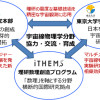
Research Collaboration Agreement Signed to Expand the Field of Multi-Messenger - RIKEN CPR, iTHEMS and ICRR The University of Tokyo
By October 22, RIKEN Cluster for Pioneering Research, iTHEMS and Institute for Cosmic Ray Research concluded a research collaboration agreement to further promote research cooperation in the field of multi-messenger cosmic ray physics, including joint research and personnel exchanges.
-
2020-08-03
Press Release
Tetsuo Hatsuda × Yoshinori Ohsumi × Sayaka Oki Online Discussion: "The Usefulness of 'Useless' Knowledge" will be held on August 22!
academist, Inc. and RIKEN iTHEMS are pleased to announce the presentation of "Tetsuo Hatsuda x Yoshinori Ohsumi x Sayaka Oki Online Discussion: "The Usefulness of ‘Useless' Knowledge" on Saturday, August 22, 2020 at 1:00 pm.
-
2020-07-10
Press Release
When adaptation promotes coexistence
Peafowl males have prominent ornaments, birds song for courtship, and flowers are beautiful and attractive for pollen transporters. Such characteristics appear to be adaptive at the level of individuals, but do not necessarily increase population growth rate. Therefore, these are, at the level of species, “wasteful”, making the species weaker to other species in competition for resources. Our collaboration group named this process as “intra-specific adaptation load,” and developed mathematical models, showing that strong intra-specific competition leads to a coexistence of a number of species that would have otherwise excluded each other (“competitive exclusion”). This new mechanism, which has been rarely considered in biodiversity research, may actually play a pivotal role in maintaining the biodiversity on earth.
-
2020-07-09
Press Release
Black Hole as a Quantum Field Configuration
A joint research team led by Yuki Yokokura, a senior researcher at the Interdisciplinary Theoretical and Mathematical Sciences Program at RIKEN, has theoretically described the interior of an evaporating black hole using quantum mechanics and general relativity. The results of this research will provide an insight into the nature of black holes, and are expected to provide a basic theory of "black hole engineering" that will utilize black holes as devices to store information in the distant future. The study was published in the online scientific journal Universe on June 4.
-
2020-03-05
Press Release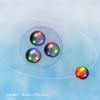
New Hypernucleus "Xi-Tetrabaryon" -- Unravelling the behavior of Xi-particle by high-precision computations
An international research group including Dr. Tetsuo Hatsuda (Program Director, iTHEMS), and Takumi Doi (Senior Research Scientist, iTHEMS / Quantum Hadron Physics Laboratory, RIKEN) has theoretically predicted the existence of a new hyper-nucleus (hypernucleus), the Xi-Tetrabaryon, consisting of one Xi-particle and three nucleons. Please see the related link for details
-
2019-09-04
Press Release
Genomic analysis of 370 Japanese Thoroughbred horses: the genetic background of why Thoroughbreds can run fast
Humans have been trying to improve Thoroughbreds by selectively breeding horses that can run fast. Each generation, a small number of males are selected to breed so that only these “elite” males can pass on their genes to the following generation. In this study, we examined how this continuous artificial selection has affected the evolution of the genomes of Thoroughbreds. First, we found that the genetic diversity is low in Thoroughbreds due to repeated inbreeding since even before the establishment of Thoroughbreds. Second, we found several regions that exhibit signatures of artificial selection. These regions typically show locally reduced genetic variation and should contain genes that are important for the athletic performance of Thoroughbreds. This study opens the way for genomic information to be utilized in the selective breeding of Thoroughbreds.
-
2019-08-02
Press Release
Is your Supercomputer Stumped? There May Be a Quantum Solution
The recent paper by Jason Chang* (iTHEMS/UCB/LBNL), Shigetoshi Sota* (R-CCS) and their collaborators in US, "Quantum annealing for systems of polynomial equations" (Nature Scientific Reports, 9 (2019) 10258), was press-released on Aug.1, 2019 with a headline - Is your Supercomputer Stumped? There May Be a Quantum Solution - (*) Both Jason and Shigetoshi are members of the iTHEMS QCoIn Working Group.
-
2019-04-11
Press Release
Observation of Quantized Heating Rate in Ultracold Topological Matter
An international collaboration of researchers from University of Hamburg, Université libre de Bruxelles, and RIKEN iTHEMS observed quantized heating rate, demonstrating a novel universal probe for topological states of matter. The experiment was performed using a gas of ultracold potassium atoms. The researchers looked for the difference in heating rate upong "shaking" the system clock-wise and counter-clock-wise, and confirmed that this different is quantized to the value of the "Chern number" of the system, a topological invariant characterizing a two-dimensional system. The experiment took place in Hamburg, with theoretical collaborations from theorists in Bruxelles and RIKEN iTHEMS.
-
2019-04-03
Press Release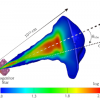
Researchers pinpoint origin of photons in mysterious gamma-ray bursts
Scientists from the RIKEN Cluster for Pioneering Research and collaborators have used simulations to show that the photons emitted by long gamma-ray bursts—one of the most energetic events to take place in the universe—originate in the photosphere—the visible portion of the “relativistic jet” that is emitted by exploding stars.
-
2019-02-21
Press Release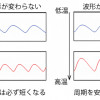
Non-sinusoidal Waveform in Temperature-Compensated Circadian Oscillations
Shingo Gibo (Postdoctoral Researcher, iTHEMS) and Gen Kurosawa (Senior Research Scientist, iTHEMS) have published a press release.
-
2018-12-18
Press Release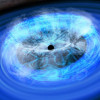
Mystery of coronae around supermassive black holes deepens
Researchers from RIKEN and JAXA have used observations from the ALMA radio observatory located in northern Chile and managed by an international consortium including the National Astronomical Observatory of Japan (NAOJ) to measure, for the first time, the strength of magnetic fields near two supermassive black holes at the centers of an important type of active galaxies. Surprisingly, the strengths of the magnetic fields do not appear sufficient to power the “coronae,” clouds of superheated plasma that are observed around the black holes at the centers of those galaxies.
-
2018-10-16
Press Release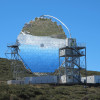
The First Telescope of a New Observatory for High-Energy Gamma-Ray Astronomy Makes its Debut
Several iTHEMS members are actively involved in a brand-new, cutting edge astronomical project, called the Cherenkov Telescope Array (CTA). CTA will be the foremost global observatory for very high-energy gamma-ray astronomy over the next decade and beyond and will be the first ground-based gamma-ray astronomy observatory open to the world-wide astronomical and particle physics communities. The scientific potential of CTA is extremely broad: from understanding the role of relativistic cosmic particles to the search for dark matter. With its ability to cover an enormous range in photon energy from 20 GeV to 300 TeV, CTA will improve on all aspects of performance with respect to current instruments. From iTHEMS, Susumu Inoue and Yoshiyuki Inoue in particular have been actively contributing to the science case studies of multi-messenger transient phenomena and supermassive black holes as members of the CTA Consortium. On Wednesday, 10 October 2018, more than 200 guests from around the world gathered on the northern array site of the CTA to celebrate the inauguration of the first prototype Large-Sized Telescope (LST). The telescope, named LST-1, is intended to become the first of four LSTs on the north site of the CTA Observatory, which is located on the existing site of the Instituto de Astrofisica de Canarias’ (IAC’s) Observatorio del Roque de los Muchachos located in the municipality of Villa de Garafia on the island of La Palma. The plan for the site also includes 15 Medium-Sized Telescopes (MSTs). The LSTs will expand the science reach to cosmological distances and fainter sources with soft energy spectra. Both the repositioning speed and the low energy threshold provided by the LSTs are critical for CTA studies of transient gamma-ray sources in our own Galaxy and for the study of active galactic nuclei and gamma-ray bursts at high redshift.
-
2018-09-11
Press Release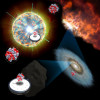
An unstable isotope Technetium-98 (98Tc) could be synthesized by neutrinos emitted from supernova explosions
A joint research group consisting of Masaomi Ono, a Research Scientist at RIKEN, and others has theoretically predicted that an unstable isotope Technetium-98 (98Tc) could be synthesized by neutrinos emitted from supernova explosions. Supernovae are important events in the evolution of stars and galaxies, but the details of how the explosions occur are still unknown. This research found a method to investigate the role of electron anti-neutrinos in supernovae. By measuring the amount of 98Ru (an isotope of Ruthenium) in meteorites, it should be possible to estimate how much of its progenitor 98Tc was present in the material at the time when the Solar System formed. The amount of 98Tc in turn is sensitive to the characteristics, such as temperature, of electron anti-neutrinos in the supernova process; as well as to how much time passed between the supernova and the formation of the Solar System. (This work appeared in Physical Review Letters on Sept. 4, 2018.) Caption: We can estimate the age of heavy elements in the primordial Solar System by measuring the traces left in meteorites by specific radioactive nuclei synthesized in certain types of supernovae. Credit: NAOJ (National Astronomical Observatory of Japan)
-
2018-07-26
Press Release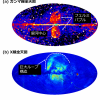
Diffuse x-ray emission from the northern arc of loop I observed with suzaku
The research team, including Yoshiyuki Inoue (Senior Research Scientist, iTHEMS), have published a press release.
-
2018-07-20
Press Release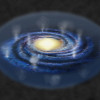
Spatial Distribution of the Milky Way Hot Gaseous Halo Constrained by Suzaku X-Ray Observations
The research team, including Yoshiyuki Inoue (Senior Research Scientist, iTHEMS), have published a press release.
-
2018-06-22
Press Release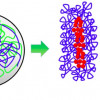
Modeling the functions of condensin in chromosome shaping and segregation
Former iTHES fellow, Yuji Sakai (Univ. Tokyo) together with Atsushi Mochizuki (iTHEMS), Masashi Tachikawa (iTHEMS), Tetsuya Hirano (RIKEN) and Kazuhisa Kinoshita (RIKEN) have published a paper and a press release. Immediately before a cell divides, chromosomal DNA in a eukaryotic cell is packaged into a discrete set of rod-shaped chromosomes. This process, known as mitotic chromosome assembly or condensation, secures the faithful segregation of genetic information into daughter cells. Central to this mechanistically complex process is a class of protein complexes known as condensins. However, how condensins support the assembly and segregation of mitotic chromosomes at a mechanistic level remains elusive. Here we construct a coarse-grained physical model of chromosomal DNA fibers and condensin molecules, and study how condensins work in the mitotic chromosome assembly using computer simulations. Our results show that two activities of condensins, formation of consecutive loops in chromosomal DNA fibers and inter-condensin attractions, are necessary for both the shaping and segregation of mitotic chromosomes, and balancing acts of these activities help to coordinate the efficient progress of the processes. Importantly, chromosome shaping and segregation in our results are strongly correlated, implying that they are controlled by the same underlying mechanism mediated by condensins.
-
2018-06-05
Press Release
Neutron Life from Supercomputer Simulations
Jason Chang (iTHEMS/LBNL) and his colleagues have enlisted powerful supercomputers to calculate a quantity known as the "nucleon axial coupling," – which is central to our understanding of a neutron’s lifetime – with an unprecedented precision. Their method offers a clear path to further improvements that may help to resolve the experimental discrepancy of the lifetime of neutrons as well as to learn about as-yet undiscovered physics. The paper was published was published online May 30 in the journal Nature.
-
2018-05-24
Press Release
Using the K computer, scientists predict exotic “di-Omega” particle
Based on complex simulations of quantum chromodynamics performed using the K computer, one of the most powerful computers in the world, the HAL QCD Collaboration, made up of scientists from the RIKEN Nishina Center for Accelerator-based Science and the RIKEN Interdisciplinary Theoretical and Mathematical Sciences (iTHEMS) program, together with colleagues from a number of universities, have predicted a new type of “dibaryon”—a particle that contains six quarks instead of the usual three. Studying how these elements form could help scientists understand the interactions among elementary particles in extreme environments such as the interiors of neutron stars or the early universe moments after the Big Bang.
78 news
